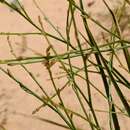en
names in breadcrumbs


Corynotheca licrota, otherwise known as the antler zig-zag lily,[1] club-fruit lily,[1] or sand lily,[2] is a perennial herbaceous member of the family Asphodelaceae and is found in arid inland areas of Australia.
Corynotheca licrota is a tufted shrub that grows up to 700mm and is grass-like in appearance. The leaves are linear in shape and can grow up to 600mm. [2] Stems are much shorter at 5mm long. [3] Inflorescence are widely branched with solitary flowers. Petals are white to cream to pale yellow in colour and sepals are often a darker pink to purple to brown colour. [2][3] The petals are a narrow elliptical shape that are 3.9-5.5mm long and 0.7-0.9mm wide. The pendulous capsules are brown and wrinkly looking and ovoid to obovoid in shape. They are 2.8-7.5mm long and 2.1-2.8mm wide. 1-5 seeds are found in each fruit. They are glossy black to iridescent in colour and have a smooth or slightly corrugated texture. Flowering occurs mostly from September to February but can also occur in April and August after rainfall. [3]
This species is endemic to Australia and occurs mostly in the arid areas of the country. However, it has been found in all states excepting Tasmania. [1] Three fairly distinct populations have been noted in the central ranges, Murray-Darling Basin and southern SA. Distribution has been tracked along drainage paths of the Darling and lower Murray, which suggests seeds may be carried from Central Australia by the rivers. [3] It is common that C. licrota grows on sandy plains or dunes in low rainfall areas, [1] and often in conjunction with mallee scrub or pine-buloke forests. [2] Corynotheca species are key in their habitat because of the dense shelter they provide invertebrates and small vertebrates and their ability to resprout rapidly after fires. [3]
This species is listed as Endangered in Victoria,[2] Rare in South Australia,[4] Near Threatened in the Northern Territory,[5] of Least Concern in Queensland,[6] Not Threatened in Western Australia,[7] and not currently listed in New South Wales[8] and the Australian Capital Territory.[9] It is not listed under the Environment Protection and Biodiversity Conservation Act 1999.[10]
This species was first formally classified at species rank by Australian botanist Rodney John Francis Henderson in 1987 in the Flora of Australia collection. [11] Prior to this, C. licrota was included under Corynotheca lateriflora and separated at varietal rank by Austrian botanist Erwin Gauba. [3]
Synonyms for Corynotheca licrota include:
Corynotheca licrota and C. lateriflora are similar and easily misidentified.[3]
Corynotheca licrota, otherwise known as the antler zig-zag lily, club-fruit lily, or sand lily, is a perennial herbaceous member of the family Asphodelaceae and is found in arid inland areas of Australia.